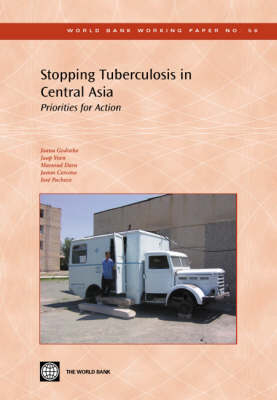
Stopping Tuberculosis in Central Asia
Priorities for Action
Seiten
2005
World Bank Publications (Verlag)
978-0-8213-6276-1 (ISBN)
World Bank Publications (Verlag)
978-0-8213-6276-1 (ISBN)
Reviews the epidemiological situation, control efforts, and financing of tuberculosis programs in Kazakhstan, Kyrgyz Republic, Tajikistan, and Uzbekistan. Based on a review of statistics and reports, this work contributes an agenda for action to address the epidemiological crisis that has been posed by the increase in cases of HIV/AIDS infection.
Tuberculosis is still a significant health and economic problem in Central Asia, despite some recent progress that may be due to improvements of the overall economic situation in these countries, and partial adoption of the DOTS Strategy recommended by WHO. Over 50,000 new cases have been detected in 2003 and over 7,000 people died due to TB in the four countries studied. This study has confirmed that it is highly unlikely that these Central Asian republics will succeed in achieving the global targets for tuberculosis control in the short term, particularly with regard to case detection. In the meantime, the epidemic continues to have a serious epidemiological impact and affects the economies of these countries, which incur productivity losses and indirect costs that are estimated to range from 0.5 to 0.8 percent of GDP annually. Stopping Tuberculosis in Central Asiareviews the epidemiological situation, control efforts, and financing of tuberculosis programs in Kazakhstan, Kyrgyz Republic, Tajikistan, and Uzbekistan. It was based on a review of existing statistics and reports, and on consultation with key stakeholders? Governments, NGOs, and donors in Central Asia. This work contributes an agenda for action to address the impending epidemiological crisis that has been posed by the sudden increase in cases of HIV/AIDS infection combined with a prevalent epidemic of TB.
Tuberculosis is still a significant health and economic problem in Central Asia, despite some recent progress that may be due to improvements of the overall economic situation in these countries, and partial adoption of the DOTS Strategy recommended by WHO. Over 50,000 new cases have been detected in 2003 and over 7,000 people died due to TB in the four countries studied. This study has confirmed that it is highly unlikely that these Central Asian republics will succeed in achieving the global targets for tuberculosis control in the short term, particularly with regard to case detection. In the meantime, the epidemic continues to have a serious epidemiological impact and affects the economies of these countries, which incur productivity losses and indirect costs that are estimated to range from 0.5 to 0.8 percent of GDP annually. Stopping Tuberculosis in Central Asiareviews the epidemiological situation, control efforts, and financing of tuberculosis programs in Kazakhstan, Kyrgyz Republic, Tajikistan, and Uzbekistan. It was based on a review of existing statistics and reports, and on consultation with key stakeholders? Governments, NGOs, and donors in Central Asia. This work contributes an agenda for action to address the impending epidemiological crisis that has been posed by the sudden increase in cases of HIV/AIDS infection combined with a prevalent epidemic of TB.
| Erscheint lt. Verlag | 11.7.2005 |
|---|---|
| Verlagsort | Washington |
| Sprache | englisch |
| Themenwelt | Medizinische Fachgebiete ► Innere Medizin ► Pneumologie |
| Studium ► Querschnittsbereiche ► Prävention / Gesundheitsförderung | |
| ISBN-10 | 0-8213-6276-3 / 0821362763 |
| ISBN-13 | 978-0-8213-6276-1 / 9780821362761 |
| Zustand | Neuware |
| Haben Sie eine Frage zum Produkt? |
Mehr entdecken
aus dem Bereich
aus dem Bereich
Aus der Praxis für die Praxis
Buch (2022)
Thieme (Verlag)
CHF 99,40
International Trauma Life Support (ITLS)
Buch | Softcover (2024)
Hogrefe AG (Verlag)
CHF 91,00


